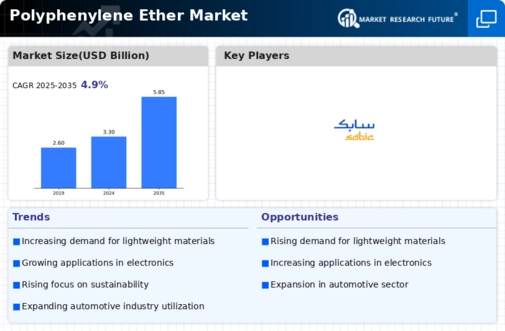Market Growth Projections
The Global Polyphenylene Ether Market Industry is projected to experience robust growth, with a market value expected to reach 5.85 USD Billion by 2035. This growth trajectory indicates a compound annual growth rate (CAGR) of 5.35% from 2025 to 2035. Such projections suggest a strong demand for polyphenylene ether across various sectors, driven by its unique properties and versatility. The anticipated expansion reflects not only the material's increasing acceptance but also its potential to meet the evolving needs of industries, positioning it as a key player in the global materials market.
Rising Environmental Regulations
The Global Polyphenylene Ether Market Industry is increasingly shaped by rising environmental regulations aimed at reducing plastic waste and promoting sustainable materials. Polyphenylene ether, known for its recyclability and lower environmental impact compared to traditional plastics, aligns well with these regulatory trends. As industries seek to comply with stringent environmental standards, the demand for eco-friendly materials like polyphenylene ether is likely to increase. This shift not only supports sustainability goals but also positions polyphenylene ether as a viable alternative, potentially enhancing its market share in various applications.
Expanding Applications in Healthcare
The Global Polyphenylene Ether Market Industry is benefiting from expanding applications in the healthcare sector. Polyphenylene ether's biocompatibility and resistance to sterilization processes make it suitable for medical devices and equipment. As the healthcare industry evolves, there is a growing need for materials that can withstand rigorous cleaning and sterilization while maintaining performance. This trend is likely to drive demand for polyphenylene ether, as manufacturers seek reliable materials for critical applications. The anticipated growth in healthcare spending and innovation in medical technologies may further enhance the market's prospects.
Increasing Demand for Lightweight Materials
The Global Polyphenylene Ether Market Industry is experiencing a surge in demand for lightweight materials, particularly in the automotive and aerospace sectors. As manufacturers strive to enhance fuel efficiency and reduce emissions, polyphenylene ether's lightweight properties become increasingly attractive. This trend is evidenced by the projected market value of 3.3 USD Billion in 2024, reflecting a growing preference for materials that contribute to overall vehicle performance. Furthermore, the lightweight nature of polyphenylene ether allows for innovative designs and applications, potentially leading to broader adoption across various industries, thereby driving market growth.
Technological Advancements in Polymer Processing
Technological advancements in polymer processing techniques are significantly influencing the Global Polyphenylene Ether Market Industry. Innovations such as advanced molding and extrusion processes enable manufacturers to produce polyphenylene ether with enhanced properties, including improved thermal stability and chemical resistance. These advancements facilitate the development of high-performance applications in electronics and automotive components. As a result, the market is expected to grow, with a projected value of 5.85 USD Billion by 2035. The continuous evolution of processing technologies may lead to new applications, further expanding the market's potential.
Growth in Electronics and Electrical Applications
The Global Polyphenylene Ether Market Industry is witnessing substantial growth driven by the increasing use of polyphenylene ether in electronics and electrical applications. Its excellent electrical insulating properties and thermal stability make it an ideal choice for components such as connectors, circuit boards, and housings. As the electronics industry continues to expand, fueled by advancements in technology and consumer demand for electronic devices, the market for polyphenylene ether is expected to flourish. This growth is indicative of the material's versatility and adaptability, suggesting a promising future for its applications in this sector.





Leave a Comment